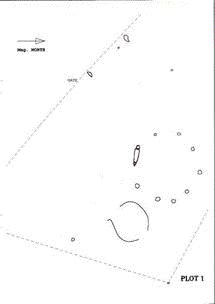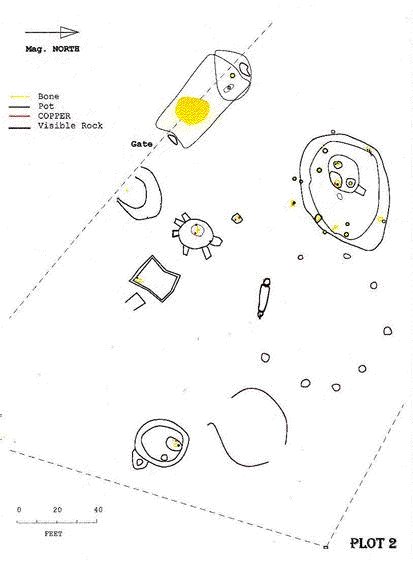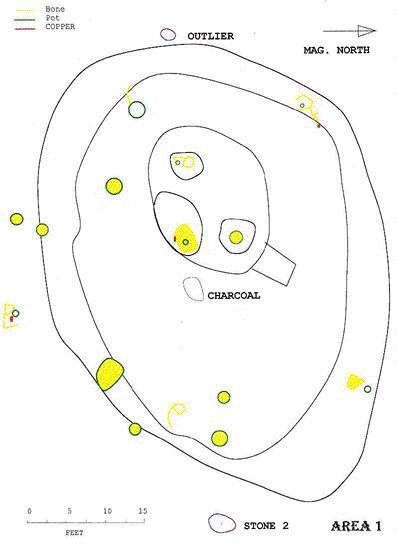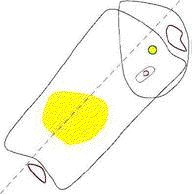| Loanhead Revisited - an alternative view of the great
recumbent stone circle, Bronze Age burial ground and sacred precinct at Loanhead of
Daviot, in the central Garioch, Aberdeenshire My
first visit to Loanhead with a dowsing rod was in 1995. I roughly plotted a lot of
shapes but decided to write up a study of New Craig, rather than Loanhead.
This was partly because New Craig was an enigma ( because so much is missing ) and partly
because I was a little shy about what I was doing and could work for months at New Craig
without seeing anyone! I returned to Loanhead in 1998 and it is interesting to
compare the new plot with what I found in 1995.
©Peter Donaldson  Loanhead plot 1 Loanhead plot 1
With one exception, (the strange buckled square near the centre), the shapes are very
close. Everything that is plotted here during 1998 and early 1999 has been plotted
in detail once, and then double checked by re-dowsing and re-plotting some of the detail a
week later. This serves two purposes. Firstly, it ensures that my measuring is
not going awry. Secondly, it ensures that what I am plotting is not imagination.
I can remember rough shapes - but not to within a few inches as to where they were!
The Loanhead site consists of an oblong parcel of fenced in land with the stone circle
about 2/3rds of the way down the NNE side of the area. The cemetery area excavated by
Kilbride-Jones is to the ESE of the stones. Plot 1 shows the visible stones, and the
recumbent is on the SSW side of the circle. The two outliers are also shown.
Plot 2 shows the whole site with small scale details of everything that I have
dowsed.
Plot2
©PeterDonaldson
For brevity for the webspace, I discuss just two of the areas. These are:- area 1, which
is the ground between the main circle and the western outlier; and area 6 which is
just inside, and to the left (west) of the entrance gate. Anyone wanting data on the rest
of the area can contact me on donaldson.meikle@virgin.net
.
AREA 1
The first features that I picked up were the double lines making a rough egg shape, with
the sharp end towards the circle. These lines are believed to be stone. Likewise,
towards the top of the interior of the oval is a smaller oval. It is similarly
orientated and has an oblong structure extending from the NE side of it. Again, this
dowses as rock and I wonder if the oblong area is a fallen stone or cist lid. While
still dowsing for rocky features, I found the three enclosures shown within the small
oval. It was when I switched to dowsing for bone that things became really
interesting! As can be seen from the large plot of Area 1, each of the enclosures
contained areas of bone. The one closest to the outlier appears to have separate
bones. It plots like a skeleton with the head to the NE but the head could equally
be several short bones laid together. There is also a single area of pottery in the
enclosure.
Loanhead Area 1 ©1999PeterDonaldson
 The larger
oval enclosure on the southeast corner of the interior oval, contains an area of
bone, a pot in the middle and a small area of copper. I am not suggesting that it is
pure copper - it is just that it is that substance that I look for. Bronze, brass
etc. are all copper based and are detected at the same time - so take YOUR pick! The larger
oval enclosure on the southeast corner of the interior oval, contains an area of
bone, a pot in the middle and a small area of copper. I am not suggesting that it is
pure copper - it is just that it is that substance that I look for. Bronze, brass
etc. are all copper based and are detected at the same time - so take YOUR pick!
The third enclosure is the first of several identical features that I have found round the
entire site. It is an almost circular area of bone and pottery mixed. This
could either be just that - bones and shards of pot dumped in a pile. Or it could be
a Cinerary Urn. As can be seen, I found 7 of these objects in, or close to the large
ovals. There is also a larger area of bone and pottery in the south-eastern quadrant -
straddling the inner and outer face of the last oval. The area also contains a total of
what appear to be 5 complete skeletons and 3 areas of bone without any real shape.
Also of note is the fact that copper is not found with any of the urns. In this
area, it only appears with 2 skeletons and with the area of bone in the smaller oval.
One of a couple of setbacks (and lessons!) that I have had with dowsing concerned a nice
oval that I found in an unprotected area elsewhere. A friend and I decided to have a dig
and became quite excited as we began to unearth charcoal. However, it turned out to be the
remains of the root system of a tree that had been struck by lightning. After this
debacle, I am reluctant to dowse for charcoal for obvious reasons! Sure enough,
there are bits of charcoal all over the site and not necessarily of any relevance to
anything other than natural processes. However, I have plotted one area because it
struck me as interesting that it is exactly halfway between stone 2 in the circle - and
the outlier.
I think that this whole area is a repeat of the excavated burial ground area to the
east. It is (or was) rather more complicated and there appear to be several cists
within the area. Otherwise it appears to have the same elements. Mr Kilbride-Jones
found 11 pots in his excavation compared with 13 pots and one area of pottery in my survey
of this place. If one examines plot 2, it can be seen that area one and the cemetery
are neatly placed either side of the stone circle and are nearly equidistant from the
recumbent's flanker stones.
AREA 6
And so to what I think is the most significant find of all. I found the oblong
structure because I was intrigued by the rock by the gate. It is about 45 feet by 20
and goes through the fence into the woods where I managed to continue to trace it -
inspite of hitting my head on several branches! At the northwest end of it, there is
a nice oval on the Loanhead side of the fence - which becomes distorted amongst the trees.
At the centre of this, there appears to be a cinerary urn with bone.
The knockout discovery for me was the huge area of bone about 6 feet from the southeastern
end.
 Area6
Loanhead please click here for fullsize image Area6
Loanhead please click here for fullsize image
There is also traces of pottery in this area but not in a solid mass.
So is this the mortuary house? The structure is located where there is a slope but
as the northwest dowses deeper than the south-east, perhaps the buried structure was
either dug into the slope, or the area was more level 4000 years ago. If I could persuade
the authorities to have a dig, it would be here. (and Area 1.) The bone dowsing
signal is very strong and would almost certainly yield something of interest.
People who have read my notes on New Craig may note that I have refrained from making date
comments about the various finds in this survey. The simple fact is that many of the
dates that I obtained for New Craig (from authoritative sources) were already out of date
by the time I published it. As information grows, so many dates (first stone
circles, Beaker folk, introduction of copper etc) are being revised. Suffice to say
that Loanhead was constructed 3 - 3500 years b.c. and everything else stems from that.
SUMMARY
There is much surrounding the Loanhead site still to be found. There have already been
finds in the field to the NNE of the circle and I plan to have a look there. The
woods have many interesting rocks - some with cupmarks - and I am sure that there are more
structures to be revealed. In the meantime, what of Loanhead?
I think that what strikes me most is the fact that there must have been a lot of people
living in this area 2-3000 years bc. , Newcraig is easily visible from Loanhead.
There was an equal sized circle down in Daviot 1/2 mile in the opposite direction and one
assumes that each circle a) took a lot of people to construct and b) judging by the
activity revealed by the various surveys, served a lot of people as well. It is
possible that one group of people and their descendants built the three circles - moving
their area of operations 1/2 mile north every 100 years or so - but this is extremely
unlikely. I am sure that the circle was the the parish church of its time.
Yes, we can add sacrifices to the activities. For some reason, a few people do not
wish to consider this. I cannot see why not. Sacrifices were made in bibilical
times and, from the standpoint of ancient man - they made perfect sense. If one had
reached the stage of believing that the unexplainable had a supernatural (gods, deities
etc) cause, then what is more sensible to try and please them at a time that suited
you? Cattle die unexpectedly so it is obvious that the Gods take them. If one
spring you try killing a few that suit you and offering them in some ritual way, and this
is followed by one of the best seasons for years, it would be stupid not to keep the
process going. It is interesting that the circles had their initial decline as the
climate worsened again. This will probably be due, in part, to the declining
population. But if nothing seems to appease the gods anymore - why keep wasting time
with it.
This is the nice thing about archaeology. I am not trained in the subject and I make
no pretence as to the fact that a trained eye will see so much more than I can. But
my speculation is just as good as the next person's. And so is yours! Enjoy
our heritage and KEEP SPECULATING!
©Peter Donaldson - Spring 1999
Note: Loanhead of Daviot is situated at grid reference NJ747288 on the outskirts of the
village of Daviot near Inverurie in the Garioch heartland. The excavation by
Kilbride-Jones referred to was published in 1935 in the Proceedings of the Society of
Antiquaries of Scotland (PSAS 69, pp168-222). Finds are in several
collections, including the Museum of Scotland, Edinburgh and NE Scotland Museums Service,
Peterhead [MY].
Capt. Peter Donaldson is a member of  |
